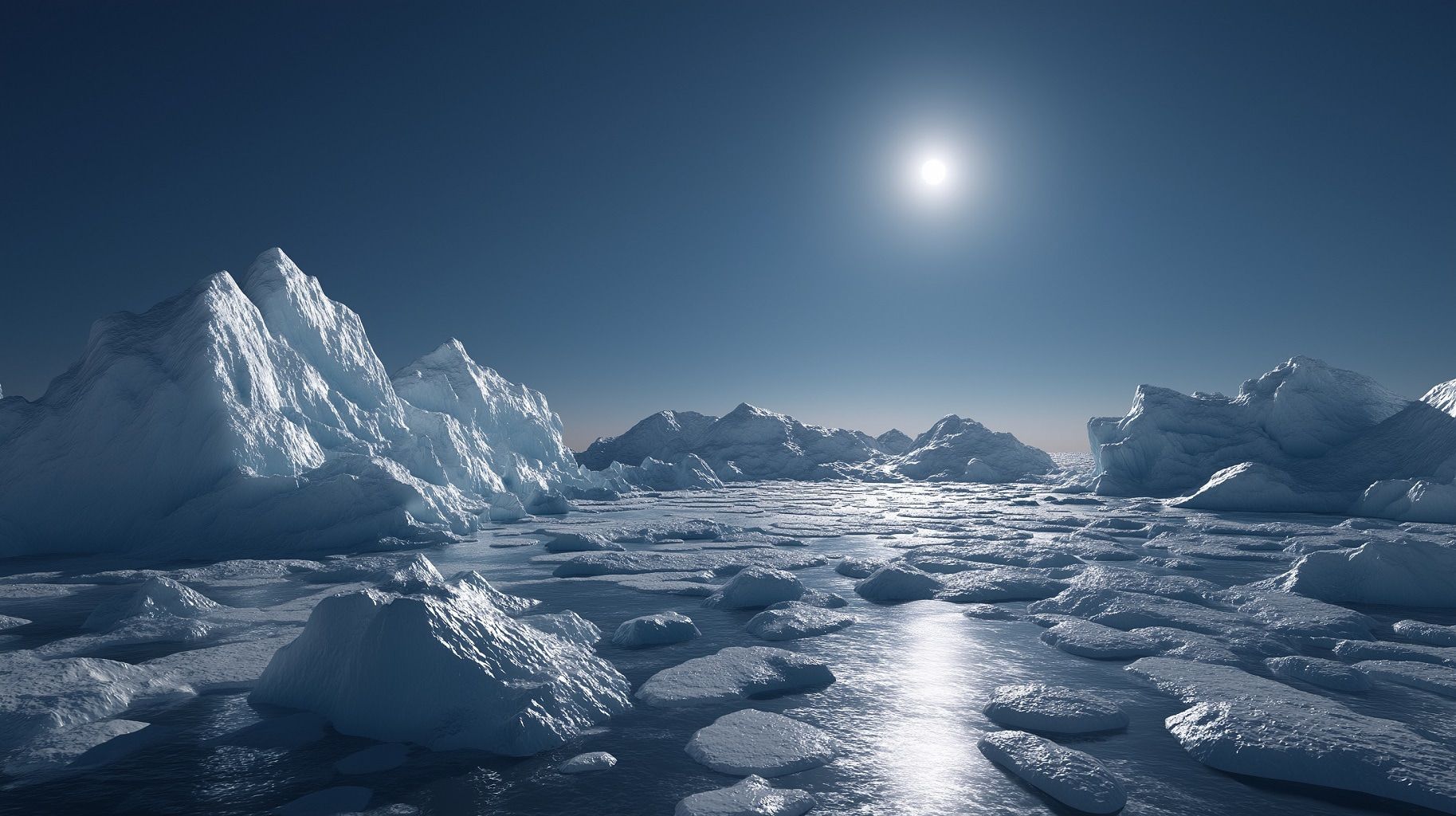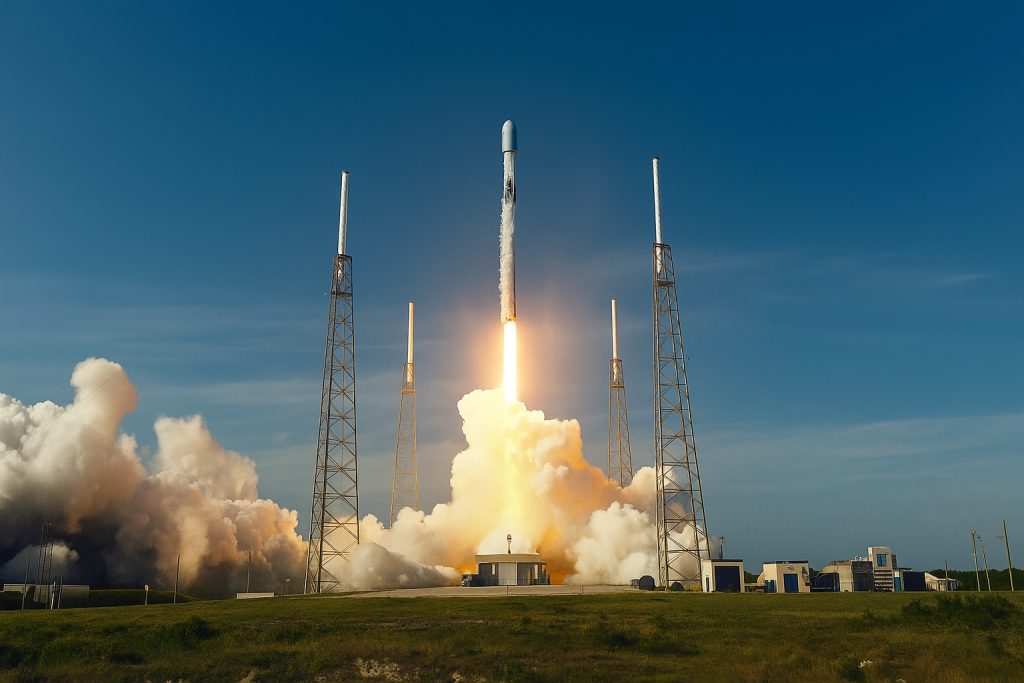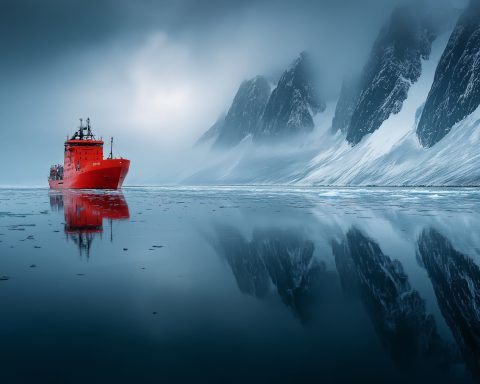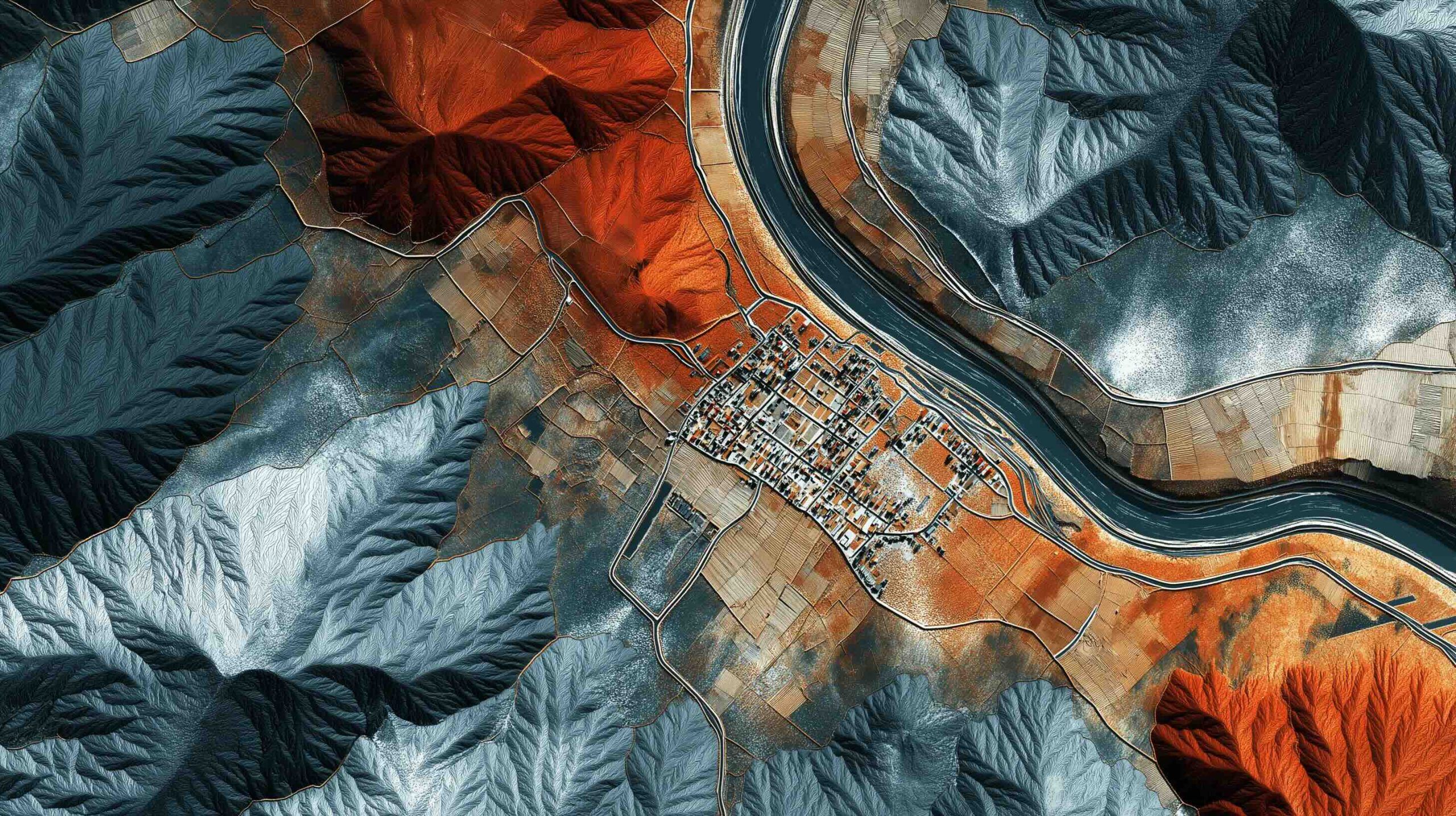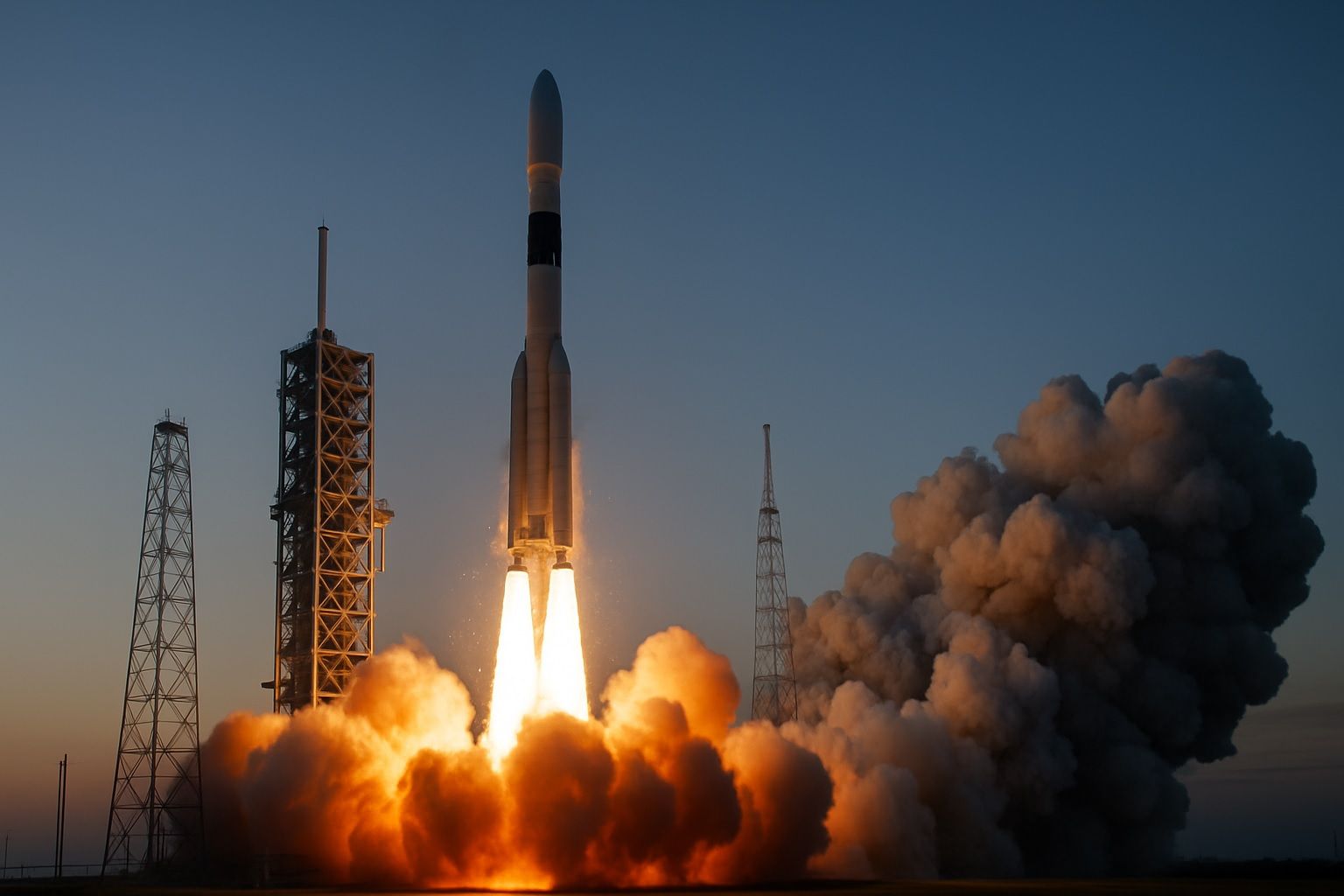- ICESat-2 (NASA) launched September 15, 2018 on a Delta II rocket and carries the Advanced Topographic Laser Altimeter System (ATLAS), a photon-counting laser that operates from a ~481 km near-polar orbit (92°) with ground tracks repeating every 91 days to map ice sheets, sea-ice freeboard, glacier height, and forest canopy.
- CryoSat-2 (ESA) launched April 8, 2010 on a Dnepr rocket, in a ~717 km, 92° inclined drifting orbit not sun-synchronous and reaching up to 88° latitude to measure ice thickness on land and sea.
- ICESat-2 fires about 10,000 laser pulses per second (532 nm green) with six beams, producing an ~11 m footprint and elevation changes detectable to ~4 mm, with along-track spacing of roughly 0.7 m and orbit knowledge within 5 m.
- CryoSat-2 uses the SIRAL radar altimeter (Ku-band, 13.6 GHz) in SAR and SARIn modes, with a footprint of a few hundred meters, able to operate in darkness and through clouds, and can penetrate snow to measure ice thickness, with sensitivities around 1.6 cm/yr for sea-ice thickness and ~3 cm/yr for ice-sheet elevation.
- In 2020, the Cryo2Ice orbital alignment nudged CryoSat-2 so that every 19th CryoSat-2 orbit overlaps with every 20th ICESat-2 orbit, enabling near-simultaneous snow-depth measurements over a ~3,000 km stretch of Arctic sea ice.
- CryoSat-2 produced the first high-resolution Arctic sea-ice thickness maps in 2011 and, by 2014, provided 14 million km² Greenland/Antarctic elevation models that highlighted rapid thinning at Jakobshavn and Pine Island glaciers.
- A 2020 study combining ICESat and CryoSat data estimated Greenland ice loss at ~200 Gt/yr and Antarctica at ~118 Gt/yr, about 14 mm of global sea-level rise from 2003 to 2019.
- By 2023, CryoSat-2 swath altimetry enabled volume-change estimates for essentially all non-Greenland/Antarctica glaciers, finding a 2% global glacier volume loss from 2010 to 2020 (≈2,720 Gt) and a ~0.75 mm/yr contribution to sea level.
- A 2024 CPOM cross-validation found CryoSat-2 and ICESat-2 Greenland height changes agreeing within about 3%, with Greenland losing ~2,347 km³ between 2010 and 2023 and fast-flowing Jakobshavn and Zachariae thinning by tens of meters.
- Looking forward, researchers plan unified dual-altimeter ice-sheet assessments, ESA’s CRISTAL radar altimeter launching around 2027 to extend the record, and NASA discussions of ICESat-3 for the 2030s to maintain long-term coverage.
In a world warming faster than ever, the planet’s frozen extremes are undergoing dramatic change – and two ingenious satellites are on the front lines of discovery. NASA’s ICESat-2 and ESA’s CryoSat-2 use cutting-edge laser and radar technology, respectively, to map our planet’s ice in unprecedented detail from space. These twin missions have revolutionized how we observe the cryosphere – Earth’s frozen realms of ice sheets, glaciers, and sea ice – uncovering startling truths about melting ice and rising seas. In this report, we’ll explore each mission’s goals and technology, their breakthrough findings, and how together they’re transforming climate science and policy. Prepare for a journey to the frozen frontier through the eyes of two satellites that are rewriting the story of Earth’s ice.
Mission Overview: Two Missions, One Frozen Goal
ICESat-2 (NASA) – The Ice, Cloud, and land Elevation Satellite-2, launched September 15, 2018 on the final Delta II rocket, is NASA’s advanced follow-up to the original ICESat mission (2003–2009). Operated by NASA’s Goddard Space Flight Center, ICESat-2 carries a single but powerful instrument: a photon-counting laser altimeter. From a 481 km near-polar orbit (inclination 92°) [1], it continuously measures the height of Earth’s surface – primarily focusing on ice sheet elevations, glacier thickness, sea-ice freeboard (the height of ice above water), and even forest canopy heights – with extreme precision. The mission’s purpose is to monitor how ice is changing in a warming climate: it quantifies changes in the Greenland and Antarctic ice sheets (and the processes driving those changes), tracks sea-ice thickness through the seasons, and also measures land topography and vegetation globally. By design, ICESat-2 maps the entire Earth every 91 days (its ground track pattern repeats each 91-day cycle), ensuring seasonal revisits to polar regions. In short, ICESat-2 was built to be NASA’s laser spyglass on Earth’s ice, capturing fine-scale elevation changes that reveal ice loss or growth with each pass.
CryoSat-2 (ESA) – The European Space Agency’s CryoSat-2, launched April 8, 2010 on a Dnepr rocket [2], is Europe’s first dedicated ice-monitoring satellite. It is actually a replacement for the original CryoSat-1, which was lost to a launch failure in 2005 [3]. CryoSat-2 operates in a slightly higher polar orbit (~717 km altitude, 92° inclination) that is not sun-synchronous (its orbit drifts through different local times). This “drifting” orbit maximizes coverage up to 88° latitude [4], nearly reaching the poles. The spacecraft’s singular focus is measuring ice thickness changes on both land and sea – from the vast continental ice sheets of Antarctica and Greenland to the floating sea ice in the Arctic Ocean [5]. Over its nominal 3.5-year mission (now extended well beyond), CryoSat-2 was tasked with providing conclusive evidence of whether and how fast polar ice is diminishing, to improve our understanding of ice’s role in the climate system [6]. In essence, CryoSat-2 serves as ESA’s radar eye on Earth’s ice, watching for the subtle thinning of ice sheets and sea ice that signal big changes in our climate.
Quick Comparison: Despite their shared goal of monitoring the cryosphere, ICESat-2 and CryoSat-2 have distinct designs and strengths. The table below summarizes some key facts:
| Feature | NASA ICESat-2 (Laser Altimeter) | ESA CryoSat-2 (Radar Altimeter) |
|---|---|---|
| Launch (Agency) | Sept 15 2018 (NASA) | Apr 8 2010 (ESA) [7] |
| Orbit & Coverage | ~481 km altitude; 92° polar inclination [8]. Repeats ground tracks every 91 days (global coverage up to ~88°N/S). | ~717 km altitude; 92° inclination. Drifting orbit (non-sun-sync) with 369-day full cycle (coverage up to 88°N/S). |
| Primary Instrument | ATLAS – Advanced Topographic Laser Altimeter System (532 nm green laser) [9]. Photon-counting lidar (6-beam) measuring surface heights. | SIRAL – SAR/Interferometric Radar Altimeter (Ku-band radar). Synthetic-aperture radar altimeter with interferometry for precision. |
| Measurement Technique | Fires ~10,000 laser pulses per second, timing photon returns to measure elevation to within ~1 inch (2.5 cm). Tiny footprint (~11 m) for fine detail. Affected by clouds (laser can be blocked). | Sends radar pulses that penetrate clouds and snow, reflecting off ice surfaces. Larger footprint (hundreds of meters) but broad swath; can operate in darkness and through clouds. |
| Key Targets | Ice sheet elevations & volume change; sea-ice freeboard/thickness; glacier height changes; also land topography & vegetation height. | Sea-ice thickness (via freeboard); land ice sheet and glacier thickness changes; especially sensitive to changes at ice sheet edges and sea-ice cover [10]. |
| Status (2025) | Active (extended mission; designed through 2021, now operating into mid-2020s). | Active (extended mission; nominal 3.5-yr mission now extended well beyond; approved to operate into ~2027–2028). |
Technological Features: Space Lasers vs. Space Radar
ICESat-2’s Laser Precision: ICESat-2 carries ATLAS, the most advanced Earth-observing laser NASA has ever flown. This instrument emits bright green laser pulses (532 nm wavelength) and uses photon-counting detectors to record the few returning photons that bounce off Earth’s surface. Incredibly, ICESat-2’s laser fires 10,000 pulses every second, each pulse containing tens of trillions of photons. Because the beam spreads only about 11 m across on the ground, it can detect very small features – even individual snow dunes or crevasses – in the ice surface. The round-trip travel time of each laser pulse is measured with stopwatch-like accuracy of a billionth of a second, allowing scientists to determine surface elevation changes to within 4 millimeters (about the width of a pencil lead!). This unprecedented vertical precision and fine spatial resolution are what let ICESat-2 track subtle changes like annual snowfall accumulation or summer melting on ice sheets. However, a laser altimeter does have limits: clouds or heavy fog can block the light, and the laser reflects off the very top of snow or ice surfaces (it cannot see through snow). Still, ICESat-2’s six-beam configuration and high pulse rate produce a dense 3D swath of data. In fact, compared to the original ICESat, which would have measured one point per ~170 m, ICESat-2 takes measurements nearly every 0.7 m along track – effectively tracing the ice surface continuously. This “ridiculous accuracy” is supported by precise GPS orbit tracking; the satellite knows its position to within 5 m at all times. All this makes ICESat-2 a revolutionary tool to map ice in 3D detail, from towering ice sheet interiors down to sea ice floes.
CryoSat-2’s Radar Innovation: CryoSat-2 is equipped with SIRAL, a special radar altimeter designed specifically for ice. Unlike conventional radar altimeters, SIRAL operates in SAR mode (synthetic aperture radar) to improve along-track resolution, and in interferometric mode (SARIn) when over steeply sloping ice margins. It transmits Ku-band microwave pulses (at 13.6 GHz) and detects their echoes off Earth’s surface. Radar has the crucial advantage of seeing through clouds and polar night – CryoSat-2 can gather data year-round, regardless of weather or darkness. Moreover, over snow-covered sea ice, the radar waves actually penetrate the snow layer and reflect from the interface between snow and ice. This means CryoSat-2 measures the height of the ice underneath the snow, whereas a laser like ICESat-2 measures the top of the snow. By using radar interferometry, SIRAL can also detect slight height differences across its two antennas, which helps measure the surface more precisely, even across sloped terrain like an ice sheet’s edge. SIRAL’s effective footprint is on the order of a few hundred meters (larger than ICESat-2’s laser spots but still far sharper than earlier radar altimeters). Thanks to these innovations, CryoSat-2 can detect very subtle changes – on the order of 1.6 cm per year in sea-ice thickness, and ~3 cm per year in ice sheet elevation (as suggested from mission specs) – a level of sensitivity unheard of before 2010. Early in the mission, scientists noted that SIRAL’s data were “exceptionally detailed”, even revealing fine lineations in sea ice caused by wind stress that were far beyond the original mission requirements. Notably, CryoSat-2 carries no solar panels to deploy (they are fixed in an angled “roof” to ensure consistent power in its drifting orbit) – a design choice that simplified operations for its team in ESOC, Germany. Overall, CryoSat-2’s radar pioneered the continuous monitoring of ice thickness from space, proving that even the thin crust of sea ice floating on the ocean could be measured “within a few centimeters” of accuracy.
Innovations and Synergy: The contrasting technologies of ICESat-2 and CryoSat-2 are complementary by design. A laser altimeter directly measures the surface height (top of snow/ice) at high resolution, while a radar altimeter penetrates snow to measure the ice surface and can cover areas the laser might miss due to clouds. When used together, they unlock new capabilities – a prime example being the measurement of snow depth on sea ice. Since CryoSat-2’s radar reflects off the ice layer and ICESat-2’s laser off the snow layer, the difference between their measurements gives the snow thickness on top of sea ice. This was something not possible with a single instrument. In 2020, ESA undertook a bold orbital adjustment campaign called “Cryo2Ice” to maximize such synergy: they gently nudged CryoSat-2’s orbit so that every 19th CryoSat-2 orbit overlaps with every 20th ICESat-2 orbit, allowing the two satellites to measure the same swath of ice within hours of each other [11] [12]. Once this alignment was achieved, scientists began getting nearly simultaneous laser and radar readings over a ~3,000 km stretch of Arctic sea ice every day or so [13]. “Combining these two measurements from space will lead to a golden age,” said ESA’s CryoSat-2 manager Tommaso Parrinello, calling the small orbit change “a revolution for science” [14] [15]. Indeed, having ICESat-2 and CryoSat-2 in sync means researchers can, for the first time, derive snow layer thickness from space, greatly improving sea-ice thickness estimates [16]. NASA sea-ice expert Dr. Rachel Tilling noted this gives “a really exciting opportunity to measure snow depth… which we’ve never been able to do before from space”, and thus much more accurate sea-ice thickness. Better measurements of snow and ice not only tell us how the Arctic pack ice is thinning, but feed into better climate models and even more accurate navigation forecasts for ships in ice-infested waters. In summary, ICESat-2’s space laser and CryoSat-2’s space radar represent twin triumphs of engineering – different technologies aimed at the same target – and together they are far more powerful than either alone.
Scientific Objectives and Targets
Both missions share the overarching scientific objective of understanding how Earth’s ice is changing and what that means for the climate, but each has specific focus areas:
- ICESat-2’s Science Goals: As outlined by NASA, ICESat-2 is designed to “provide elevation measurements over the Greenland and Antarctic ice sheets to quantify changes in ice-sheet mass” and the processes behind those changes (e.g. changes in snowfall, melt rates, or ice flow). A core goal is to determine how much polar ice melt is contributing to sea-level rise, year by year. ICESat-2 also monitors sea-ice freeboard across the Arctic and Southern Oceans to calculate sea-ice thickness and how it varies seasonally and annually. Another objective – unique to ICESat-2 among “ice” missions – is to measure vegetation canopy height worldwide, which helps estimate biomass (this is a secondary objective that showcases the mission’s versatility). Additionally, ICESat-2 data help with studies of ocean surface topography, inland water levels, and even the height of urban areas – but its primary mission focus remains the cryosphere. In short, ICESat-2 aims to be the definitive monitor of ice loss or gain, whether it’s an entire ice sheet shedding billions of tons, or sea ice thinning from year to year, all with the precision needed to detect subtle changes. NASA explicitly ties these objectives to pressing questions: “What changes are occurring in the mass of Earth’s ice cover?” and “How are ice losses affecting sea level?”. Answering these is crucial for predicting future climate impacts.
- CryoSat-2’s Science Objectives: CryoSat-2 was conceived to answer one big question: “Are the Earth’s polar ice caps actually thinning, and if so, at what rate?” The mission’s slogan was to find “conclusive proof” of trends in diminishing ice cover [17]. To that end, CryoSat-2’s primary objectives are to measure the thickness of sea ice floating in the oceans and detect changes as small as a few centimeters per year, and to measure changes in the thickness of the ice sheets on land (including glaciers and ice caps) with equally high precision. By mapping ice thickness (not just area), CryoSat-2 fills a critical gap in understanding the true volume of ice lost to the oceans. It focuses especially on the margins of the big ice sheets – areas like Greenland’s coastal glaciers or West Antarctica’s ice streams, where most of the mass loss occurs as ice flows into the sea. CryoSat-2 also has a secondary role in measuring “marine gravity” and ocean surface topography incidentally (when it’s over open ocean), but its key science output is the annual and interannual changes in ice thickness and volume. At the mission’s outset, scientists noted difficulty in predicting polar ice changes and their impact on climate [18]; CryoSat was to provide the hard data to improve climate models. From detecting a trend in Arctic sea-ice volume to monitoring whether Antarctica’s losses are accelerating, CryoSat-2’s job is to be the quantitative yardstick for Earth’s changing ice. In essence, if a glacier thins by a few centimeters, CryoSat-2 should detect it – and over years, build a record to tell us if that glacier (or the whole ice sheet) is in decline.
It’s worth noting that the two missions were developed independently (one by NASA, one by ESA) but in parallel, and they address complementary parts of the cryosphere. ICESat-2 covers a broader range of science (land topography, vegetation, clouds) in addition to ice, whereas CryoSat-2 is laser-focused on ice thickness. Together, they create a more complete picture: ICESat-2 excels at high-resolution profiling and capturing fine vertical details, while CryoSat-2 provides wider coverage and all-weather monitoring. Both serve climate science by establishing long-term data sets needed to track trends and validate models.
Key Findings and Contributions to Climate Science
Both ICESat-2 and CryoSat-2 have made headline-grabbing discoveries, fundamentally advancing our understanding of the cryosphere’s response to climate change. Here are some of the most significant findings and contributions from these missions:
- Dramatic Sea-Ice Decline Revealed: One of CryoSat-2’s first major results (combined with earlier NASA ICESat data) was exposing how severely Arctic sea ice volume has plummeted. A U.K.-led study showed that between 2003 and 2012, Arctic sea ice volume declined by an astonishing 36% in late summer (autumn) and 9% in winter. In raw terms, the average ice volume in autumn dropped from ~11,900 km³ to 7,600 km³ – a loss of 4,300 km³, about 36%, in less than a decade. This was conclusive evidence that the Arctic sea ice is not just shrinking in area but also thinning dramatically. The thickest, oldest ice has largely disappeared from regions north of Greenland and Canada that used to be an ice stronghold. These findings confirmed the long-suspected trend predicted by models and pointed to the Arctic entering a new state dominated by thinner, seasonal ice. CryoSat-2 was the game-changer here: earlier satellites could show ice extent, but CryoSat-2 provided the first reliable measure of ice volume – the true indicator of how much ice the Arctic is losing. This sea-ice volume time series (now extended with ICESat-2) is critical for climate research, as it directly links to how much solar heat the polar oceans absorb when ice thins or disappears. Today, thanks to these missions, we have an 18+ year continuous record of Arctic sea-ice thickness. By combining ICESat (2003–09), CryoSat-2 (2010–present), and ICESat-2 (2018–present) data, scientists constructed an 18-year Arctic sea ice volume record that shows a loss of roughly one-third of winter ice volume since the early 2000s. The culprit is the shift from old, multi-year ice to thinner seasonal ice that melts each summer – a clear sign of a warming Arctic. This kind of long-term volume record simply did not exist before CryoSat and ICESat-2, and it’s revolutionizing our understanding of polar climate feedbacks.
- Ice Sheets Losing Mass at Alarming Rates: Both satellites have been pivotal in quantifying how Greenland and Antarctica are contributing to sea-level rise. In 2020, scientists released a milestone study using ICESat-2 (in tandem with the earlier ICESat) to map 16 years of ice-sheet change. The results were sobering: Greenland’s ice sheet is losing about 200 gigatons of ice per year, and Antarctica about 118 gigatons per year, on average [19] [20]. Combined, that’s a mass loss equivalent to 0.55 inches (14 mm) of global sea-level rise from 2003 to 2019 – roughly one-third of all observed sea-level rise in that period. This confirmed that polar ice melt is one of the largest contributors to rising oceans, second only to thermal expansion of warming seawater. The ICESat/ICESat-2 analysis also gave unprecedented regional detail: for example, West Antarctica’s losses (driven by ocean-induced melting of ice shelves) far outweighed the slight gains from increased snowfall in East Antarctica. In Greenland, thinning was especially pronounced in coastal sectors; major glaciers like Jakobshavn and Kangerdlugssuaq lost 4–6 m of height per year in their lower reaches – a staggering change, equating to tens of gigatons from single glacier basins. CryoSat-2 had earlier helped produce very similar estimates, providing an independent check on these numbers. In fact, a 2014 CryoSat study by the Alfred Wegener Institute found that Greenland alone was losing about 375 km³ of ice volume per year, and together Greenland and Antarctica were thinning at ~500 km³ per year – the highest rate observed in the modern satellite record at the time. This corresponds closely to the hundreds of gigatons per year now measured by ICESat-2, reinforcing confidence in these findings. Such measurements have been critical in validating climate models and assessments like the IPCC reports, which rely on observed ice losses to project future sea-level rise. They also underscore a key point: ice loss has accelerated. CryoSat-2’s Mark Drinkwater noted that since around 2009, Greenland’s volume loss doubled and West Antarctica’s tripled compared to the early 2000s. In other words, the rate of ice sheet melting is speeding up, a direct warning sign of climate change. This knowledge, made possible by precision altimetry, is informing policymakers as they plan for future sea-level rise of potentially feet per century if these trends continue or worsen.
- First Detailed Maps of Ice Thickness and Change: Both missions have generated groundbreaking maps that were impossible before. For example, CryoSat-2 produced the first high-resolution maps of Arctic sea-ice thickness in 2011, just one year after launch. These maps showed, for the first time, the distribution of thick and thin ice across the Arctic basin – information crucial for understanding winter ice growth and summer melt. The data were so detailed they even revealed how ice thickness responds to winds and ocean currents (as seen in linear features in the central Arctic). CryoSat-2 also mapped previously uncharted zones of Antarctica’s coastal ice thanks to its orbit reaching 88° south (traditional satellites only went to 81°S); suddenly, parts of the Antarctic ice sheet “could be seen for the first time from space” and monitored for change. In 2014, CryoSat-2 measurements enabled the best-yet elevation models of the Greenland and Antarctic ice sheets, with 14 million km² of coverage. Those maps revealed hotspots of change: for instance, Jakobshavn Glacier in Greenland was confirmed to be thinning faster than any other (tens of meters per year at the glacier front), and Pine Island Glacier in West Antarctica likewise showed dramatic thinning. This highlighted where the greatest instabilities lie (e.g. West Antarctica’s outlet glaciers versus East Antarctica’s relative stability). Meanwhile, ICESat-2’s dense along-track data have produced stunning high-definition views of ice surface topography – even capturing the rise and fall of floating ice shelves with tides. One novel achievement was ICESat-2 detecting the flexing and thinning of Antarctic ice shelves; it could measure their freeboard change with enough accuracy to infer thinning rates of up to 5 m/year on the vulnerable Thwaites and Crosson Ice Shelves in West Antarctica. This is important because ice shelves buttress the land ice – their thinning can herald faster glacier flow. ICESat-2 was one of the first laser altimeters to measure ice shelves in detail, opening a new avenue to monitor these “linchpins” of the ice sheets. In summary, these missions have provided not just isolated point measurements, but true maps and time-lapse portraits of Earth’s ice – transforming glaciology into a precise, data-rich science.
- Global Glacier Inventory and the “Ice Cube” Effect: A more recent breakthrough has come from CryoSat-2’s application beyond the polar caps – namely, to thousands of mountain glaciers worldwide. By creatively reprocessing CryoSat’s radar data in a high-resolution “swath” mode, scientists achieved something remarkable in 2023: they measured volume changes for essentially all of the world’s glaciers (outside of Greenland/Antarctica) over the past decade. The findings are eye-opening: between 2010 and 2020, global glaciers lost 2% of their total volume, equating to 2,720 gigatons of ice melted in just ten years. To help imagine that number – it’s like a giant cube of ice bigger than Europe’s highest mountain in size, completely melted away. Kangerdlugssup Glacier in Greenland, seen here, has been thinning by 4–6 m per year over the last 16 years due to warming – a vivid example of the type of rapid ice loss satellites have revealed. Even more significant, the study found that glacier melt (outside the ice sheets) now contributes more to sea-level rise than either Greenland or Antarctica individually. In other words, all the world’s modest glaciers together are currently adding about 0.75 mm per year to sea levels (on average, 273 billion tons of ice lost each year) – which exceeds the contribution from either ice sheet at present. This has huge implications: it affects water resources for communities (e.g. High Mountain Asia’s glaciers feed rivers that over 1.3 billion people rely on), and it means global glacier melt is a key player in near-term sea-level rise. By attributing 89% of the glacier loss to atmospheric warming (surface melt) and the rest to ocean-driven melt at glacier fronts, the study underscored that climbing air temperatures, even in high mountain ranges, are directly eating away these ice reserves. The innovation of swath altimetry on CryoSat-2 made this possible – an example of scientists squeezing more insight from the mission than originally envisioned. This work also guides future missions (like ESA’s upcoming CRISTAL) to ensure they can monitor glaciers better. Overall, it’s a prime example of how satellite data have quantified Earth’s “ice imbalance”: we now know Earth is losing over 1 trillion tons of ice per year when combining glaciers, ice sheets, and sea ice losses (a rate that has increased ~57% since the 1990s) – clear evidence of accelerating climate change.
- Cross-Validation and “Eyes on Ice” Continuity: A perhaps underappreciated contribution of having both ICESat-2 and CryoSat-2 in operation is the cross-checking and validation of results, boosting our confidence in these critical measurements. In late 2024, a team at the UK’s CPOM (Centre for Polar Observation & Modelling) published a study that combined CryoSat-2 and ICESat-2 data for the Greenland Ice Sheet. They found that the independent measurements of ice-sheet elevation change by the two satellites agreed to within 3% of each other – remarkably consistent. This affirmed that both radar and laser altimetry are accurate and can be merged to improve overall precision. By merging their data, the study created the most detailed picture yet of how Greenland’s ice is thinning: between 2010 and 2023, Greenland’s ice sheet lost about 2,347 km³ of ice (equivalent to the volume of Lake Victoria). The average thinning was ~1.2 m of ice sheet thickness lost, with lower elevations (the “ablation zone”) thinning a whopping ~6.4 m on average. Some fast-flowing glaciers like Jakobshavn saw up to 67 m of thinning, and Zachariae (NE Greenland) 75 m, over that period – huge changes that were captured by the satellites’ combined gaze. The researchers highlighted that using both missions not only improved accuracy but also provided a backup in case one satellite fails. Having multiple satellites ensures continuous monitoring – a point also made by NASA’s Thorsten Markus, who noted that leveraging radar + lidar now will help stitch together the long-term record from ICESat (2000s) to CryoSat-2 (2010s) to ICESat-2 (2020s) and soon to ESA’s next mission CRISTAL. In essence, these missions are building an unbroken climate data record of the cryosphere. The collaboration has been so successful it’s often described as observing Earth’s ice with “two eyes instead of one,” greatly enhancing depth perception (in the metaphorical sense as well as literal snow depth!). All of this gives decision-makers and scientists a much clearer, validated view of the rate at which our planet is losing ice.
These findings have far-reaching implications. They feed directly into global climate assessments and drive home the urgency of climate action. Quantifying ice loss allows scientists to pinpoint where and why ice is disappearing – be it warmer oceans eroding West Antarctica, or warmer air melting mountain glaciers. This knowledge is essential for projecting future changes. The data from ICESat-2 and CryoSat-2 have been used in numerous peer-reviewed studies and are incorporated into the Intergovernmental Panel on Climate Change (IPCC) reports to inform policy on sea-level rise. In short, the contributions of these missions extend from academic research to international climate policy, as the world relies on their data to understand the pace of climate change.
ICESat-2 vs. CryoSat-2: Strengths, Differences, and a Team Effort
Despite their common goal, ICESat-2 and CryoSat-2 each bring unique strengths to cryosphere observation, essentially complementing each other’s weaknesses:
- Laser vs. Radar – Different Eyes on Ice: ICESat-2’s laser (lidar) offers ultra-high resolution and direct surface measurements. It provides surface-level readings that capture fine details and smaller-scale features than radar can. For instance, ICESat-2 can map narrow glacier channels or the rough top of an ice sheet with point-by-point precision, and even detect thin layers of summer meltwater on ice by the change in reflectivity. However, the laser signal is hindered by clouds or heavy snowfall – it cannot see through thick cloud cover. CryoSat-2’s radar, on the other hand, can penetrate cloud cover and even some distance into snow, making it an all-weather, day/night instrument. It excels in consistently monitoring large areas like the polar oceans in winter darkness or the often-cloudy coasts of Antarctica. The radar does have a coarser footprint and “sees” the ice interface below the snow (for sea ice), which requires assumptions about snow depth to convert to total thickness – an uncertainty when used alone. Thus, ICESat-2 is like a scalpel, CryoSat-2 like a hammer: one gives fine detail but with conditions, the other gives broader coverage regardless of conditions.
- Spatial and Temporal Coverage: ICESat-2 collects a dense along-track profile of elevations but has a relatively small swath (it basically samples a line on the ground as it orbits). It achieves near-global coverage every 91 days by repeating its orbit tracks. This is great for detecting seasonal changes and inter-annual trends at specific tracks, but certain gaps exist between the tracks (e.g. the spacing between orbit tracks can be several kilometers at mid-latitudes). CryoSat-2, by contrast, with its drifting 369-day repeat orbit, does not exactly repeat ground tracks often – instead, it fills in a mesh of observations over time. In fact, before 2020 CryoSat-2 never exactly repeated tracks, which meant it could cover the spaces in between and eventually build a complete map of the ice surface. This made CryoSat-2 ideal for mapping and for detecting regional patterns (like identifying which parts of Antarctica’s coast are thinning fastest). However, not repeating tracks also meant that short-term changes (over days or weeks) might be conflated with spatial differences. ICESat-2’s regular repeats, on the other hand, allow for direct change detection on a quarterly basis. Together, the two sampling patterns are very powerful: CryoSat provides the broad context and spatial completeness, while ICESat-2 provides the precise elevation change on exact revisited tracks. When scientists combined them, they could get both wide-area coverage and precise change detection – effectively getting the best of both worlds.
- Precision and Accuracy: ICESat-2’s advertised vertical accuracy (~4 mm on flat surfaces) is slightly better than CryoSat-2’s (centimeter-level) on ice, due to the nature of laser measurement and the lack of need to penetrate snow. Over the relatively flat interior of ice sheets, ICESat-2 can detect very subtle elevation changes year to year (such as an extra snowfall event adding 10 cm of height). CryoSat-2’s accuracy in such areas can be affected by radar signal penetration into the snowpack (if the radar “sees” a bit below the surface, it might under-measure height by a few centimeters). However, CryoSat-2 compensates with sheer data density over the polar regions. It has also undergone extensive calibrations using ground and airborne campaigns (including underflights by NASA’s Operation IceBridge in the early years), and cross-comparisons with ICESat-2 now give high confidence that CryoSat’s measurements are accurate to within a few centimeters. In fact, the recent CPOM study showing only ~3% difference between CryoSat and ICESat-2 on Greenland height changes strongly indicates that both are highly accurate and essentially measuring the same reality. Each mission also carried reference devices: ICESat-2 has a laser retro-reflector array so that ground stations can precisely track its orbit via lasers, and CryoSat-2 carries a DORIS radio receiver and laser retro-reflectors for precision orbit determination. These ensure the height measurements from both can be tied to an exact geocentric reference. In short, neither instrument is fundamentally “better” – each excels under different conditions, and when both show the same signal (e.g. thinning of 10 cm/yr in West Antarctica), it greatly boosts confidence that the change is real.
- Complementary Roles – A Team Effort: Perhaps the greatest strength comes when ICESat-2 and CryoSat-2 work in tandem. We discussed their synergy for snow depth on sea ice; more broadly, they act as a check-and-balance on each other’s data and allow for continuity. If one satellite goes into safe mode or experiences a gap, the other can fill in with at least partial coverage. For example, in mid-2019 ICESat-2 had a brief safe-mode event for a few weeks; during that time CryoSat-2 continued measuring sea-ice thickness, ensuring no data gaps in time-series. Additionally, each mission’s data have been used to validate the other’s algorithms. ICESat-2’s very high-resolution profiles help refine CryoSat’s retrieval of ice freeboard in areas of complex terrain (like mixed ice types), and CryoSat’s extensive time series from 2010–2018 served as a baseline to validate ICESat-2’s early measurements after launch. The agencies too have collaborated: ESA and NASA engineers coordinated the orbital alignment in the Cryo2Ice campaign, and they now routinely share data. In 2024, for the first time, combined ICESat-2/CryoSat-2 datasets were released and used to produce joint ice-sheet assessments. The result is a more robust, cross-verified dataset that is incredibly valuable to the scientific community. As NASA’s Thorsten Markus put it, “data from [these] ‘sister missions’ are providing a consistent picture… fully exploiting their complementary nature”. The bottom line: where ICESat-2 and CryoSat-2 overlap in mission (polar ice), they strengthen each other – one measuring what the other cannot, and vice versa. And each also covers niches the other doesn’t (e.g. ICESat-2 on forest biomass, CryoSat-2 on certain ocean or gravity measurements), making both indispensable for a holistic view. If we think of Earth observation as a puzzle, ICESat-2 and CryoSat-2 are two pieces that fit together to give a much clearer picture of the cryosphere than either could alone.
Applications and Impact: From Scientists to Policymakers
The data from ICESat-2 and CryoSat-2 are not just scientific curiosities – they have practical applications that ripple from research labs to government agencies and industries around the world. Here are some key ways these missions’ data are used:
- Climate Science & Modeling: Perhaps the most important application is in improving climate models and projections. Accurate measurements of ice loss allow climate scientists to calibrate models of ice-sheet dynamics and sea-ice behavior. For example, models of the Greenland Ice Sheet can assimilate observed thinning rates from ICESat-2 to better project future melt under various warming scenarios. Sea-ice models use CryoSat-2/ICESat-2 thickness data to improve seasonal ice forecasts and long-term simulations of an ice-free Arctic summer. The data have revealed where models were underestimating ice loss (e.g. many models did not capture the rapid thinning of Arctic sea ice; the satellite volume record helped correct this). Both satellites have provided benchmark datasets – e.g. a map of Greenland and Antarctic ice imbalance – that climate modelers use as ground truth for the early 21st century when running simulations forward. The results also feed into Earth system models that couple ice, ocean, and atmosphere, thus sharpening predictions of global sea-level rise. In essence, ICESat-2 and CryoSat-2 supply the empirical evidence needed to make climate projections realistic and reliable.
- Sea-Level Rise Planning: Data on how much ice is being lost translate directly into sea-level rise estimates, which are crucial for policymakers and coastal planners. For instance, knowing that the ice sheets contributed ~14 mm to sea levels from 2003–2019 (and accelerating) helps governments plan mitigation and adaptation strategies. Coastal cities and low-lying nations look to IPCC assessments – which incorporate CryoSat and ICESat-2 findings – to decide on infrastructure like sea walls or to update flood risk maps. Additionally, continuous monitoring allows for detection of any sudden changes (for example, if a major ice shelf in Antarctica were to collapse, these satellites would measure the resulting acceleration in ice loss, giving an early warning of a potential sea-level jump). In the policy realm, such data inform emissions targets indirectly: to meet a goal of limiting sea-level rise, policymakers know how much ice loss must be curtailed by curbing warming. Agencies like NASA and ESA also produce annual mass balance reports for Greenland and Antarctica based on these satellites, which are widely cited in international climate policy discussions. In summary, the missions’ data help quantify a tangible impact of climate change (rising seas), enabling evidence-based decision-making.
- Arctic Navigation & Operations: In the Arctic, where sea ice conditions dictate the feasibility of shipping routes and resource extraction, having precise sea-ice thickness data is invaluable. CryoSat-2 data (and now ICESat-2 as well) are used operationally by groups like the U.S. National Ice Center and the European Copernicus Marine Service to generate weekly sea-ice thickness maps. These maps complement ice concentration/extent maps to guide ships traversing the Arctic – knowing where the thicker, harder ice is can be the difference between a safe passage and getting stuck in ice. As global warming opens new seasonal routes (like the Northern Sea Route along Siberia or even the trans-polar route in summer), such information is increasingly critical for commercial shippers and navies. Researchers have noted that incorporating up-to-date satellite-measured thickness into forecasting models leads to more accurate sea-ice forecasts, even just days to weeks ahead. The data also support offshore operations (like oil rigs or fishing fleets) in polar regions, by indicating ice stability. In a broader sense, by monitoring the long-term thinning of ice, these satellites inform strategic planning – for example, Arctic communities need to know if multi-year ice (which can threaten boats or coastal infrastructure) is declining, or if seasonal ice is freezing later (impacting hunting and transport). Thus, the missions have direct practical utility in the Blue Economy of the Arctic.
- Hydrology and Water Resource Management: An often overlooked application of cryospheric satellites is in managing water resources, particularly in regions dependent on glacial meltwater. The CryoSat-2 glacier study found that high-mountain Asia’s glaciers (e.g. Himalayas, Karakoram) lost 28 Gt per year in 2010–2019. This data can inform water management in countries like India, Nepal, and China, where glacier-fed rivers support agriculture and hydropower. If satellites show accelerating glacier shrinkage, it signals that future water availability in dry seasons may drop once those “water towers” lose volume. Planners can thus invest in alternative water storage or adjust allocations. CryoSat-2 data have also been used to improve glacier run-off models, which tell dam operators how much meltwater to expect each summer. In Alaska, where CryoSat detected ~76 Gt/yr of ice loss, officials monitor how glacier retreat might affect downstream fisheries and tourism. In other words, by quantifying glacial ice reserves and losses, these satellites help societies prepare for changes in freshwater supply – a critical climate adaptation issue.
- Geophysical Research (Beyond Cryosphere): The precision topography from ICESat-2 has found unanticipated uses. For example, ICESat-2’s laser measurements of forests are being used to map global biomass carbon stocks, aiding efforts to understand the carbon cycle. Its data on inland water levels (lake and river heights) are assisting hydrologists and even flood monitoring in remote regions. CryoSat-2’s radar altimeter, while focused on ice, also records sea surface height over the open ocean when not over ice; these data have been integrated into mean sea surface models and even used to map marine gravity anomalies (important for understanding ocean currents and Earth’s gravity field). Additionally, both satellites contribute to understanding Earth’s shape: measuring the geoid and dynamic topography, especially in polar regions where other satellites have sparse data. In Antarctica, for example, CryoSat-2 has helped discover hidden subglacial lakes and map the bedrock relief under ice shelves (by seeing bumps and dips in the ice surface). While these geophysical uses are ancillary, they highlight the versatile benefits of precision altimetry from space.
- Education and Public Awareness: Finally, it’s worth noting that the vivid results from these missions – such as maps of polar ice loss or visualizations of thinning glaciers – have been powerful for communicating climate change to the public. Agencies have released interactive tools and graphics (often based on ICESat-2/CryoSat-2 data) that let people explore how their world is changing. For instance, NASA’s ICESat-2 website features story maps showing sea-level rise contributions, and ESA frequently updates the public on Arctic ice conditions each winter using CryoSat data. This transparency and communication help raise awareness of the urgency of climate change, supported by hard data. The missions have effectively provided a “report card” on Earth’s ice – and the grades are concerning, capturing public attention. Policymakers, too, often reference findings like “Greenland is losing 200 Gt/year” in speeches and documents, showing how these technical results permeate into the discourse on climate action.
In sum, the data from ICESat-2 and CryoSat-2 have moved out of the exclusive realm of scientists and are actively supporting decision-making. Whether it’s a climate scientist improving predictions, a mayor planning coastal defenses, an Arctic mariner plotting a route, or a community leader in the Himalayas assessing future water, the detailed knowledge of Earth’s ice that these satellites provide is now indispensable. As Dr. Nitin Ravindra from CPOM noted, the combined satellite data sets offer “improved estimates of ice volume and mass changes [that are] incredibly useful for the scientific community and policymakers”. These missions exemplify how space technology can inform sustainable choices on Earth.
Recent Developments and Discoveries
Both ICESat-2 and CryoSat-2 continue to operate as of 2025, and recent years have seen exciting developments and ongoing discoveries:
- CryoSat-2 Extended and Adapted: Originally slated for 3.5 years, CryoSat-2 has been operational for over 15 years now – a testament to excellent engineering and mission management. In 2020, ESA performed the Cryo2Ice orbital alignment, as detailed earlier, which was a major international collaboration milestone. This campaign began in July 2020 and successfully adjusted CryoSat-2’s orbit to synchronize with ICESat-2 for synergistic measurements [21] [22]. The fruits of this effort are now evident in the improved datasets (like the snow depth retrievals and the cross-validated ice-sheet changes). In terms of mission health, CryoSat-2 did face challenges such as minor onboard system issues (there were reports of a fuel pressure leak in 2021, which engineers mitigated), but it has avoided any early mission termination. In fact, ESA has approved funding to extend CryoSat-2 at least until the launch of its successor, CRISTAL, around 2027. This is crucial to maintain continuous ice monitoring. Meanwhile, CryoSat-2’s data processing algorithms have seen updates – e.g. the 2021 release of Baseline-D data with refined retracking over sea ice – yielding more accurate thickness estimates than ever. New techniques like machine learning are also being tested on CryoSat data to estimate summer ice thickness when melt ponds usually hinder radar signals. All these developments ensure CryoSat-2 remains at the cutting edge of ice research even in its second decade of life.
- ICESat-2 Firing on All Cylinders: Since its launch, ICESat-2 has performed impressively, exceeding its baseline mission timeline (which was 3 years). By late 2021, it had already fired its 2 trillionth laser pulse – a number that highlights how massive the data collection has been. Apart from the headline findings (ice losses, etc.), ICESat-2 has enabled novel applications like mapping shallow coastal bathymetry in clear water (scientists found they could detect the seafloor in some tropical waters up to 40 m deep with the laser). However, the mission hasn’t been without hiccups: in the spring of 2022 and again in 2023, solar storms caused ICESat-2’s instrument to temporarily enter safe mode [23]. Specifically, heightened solar activity induced noise that made the laser altimeter pause data collection for several days in order to recalibrate. Fortunately, the spacecraft’s design included such contingencies, and it resumed normal operations after each event with no lasting damage. NASA has since lauded the resilience of ICESat-2’s systems in the face of solar weather. The mission was formally extended in 2023 and is expected to continue providing data through at least 2025, with the possibility of further extension if the hardware remains healthy. Scientists are keen to keep ICESat-2 running to build a longer record and potentially overlap with future missions.
- First “Unified” Ice Sheet Assessments: A very recent development (2023–2024) is the combined use of CryoSat-2 and ICESat-2 data in scientific assessments. We mentioned the CPOM study that merged the two for Greenland’s mass balance. Similarly, teams are combining them for Antarctica, and even with older ICESat and GRACE (gravity satellite) data to reconcile differences. The result is the most comprehensive view of ice-sheet change to date – essentially a high-precision time series from 2003 all the way to present. These unified assessments show, for example, that Antarctica’s annual ice loss has increased from ~76 Gt/year in 2001–2005 to ~155 Gt/year in 2016–2020 (a rough doubling), and Greenland’s from ~102 Gt to ~268 Gt in the same intervals. Having two independent altimeters in recent years added confidence to these numbers. In late 2024, NASA and ESA even held joint sessions at scientific meetings (like AGU) highlighting the “New paradigm of dual-altimeter cryosphere observing.” This bodes well for continued international cooperation in Earth observation.
- CryoSat-2 Swath Mode Breakthroughs: As noted, the 2023 swath altimetry results on glaciers were a breakthrough. This method is now being extended to parts of Antarctica and Greenland’s steep margins, where standard radar altimetry struggles. Early results are promising – for instance, swath-processed CryoSat data have revealed nuanced patterns of ice thinning near the grounding lines (where ice sheets begin to float) that were previously smoothed over. This is giving glaciologists deeper insight into how, for example, Antarctica’s outlet glaciers are responding to ocean melt. Such detailed process information helps improve physical models of ice dynamics. It’s quite remarkable that a mission launched in 2010 is still yielding new techniques and science in 2025.
- Preparing for the Next Generation – CRISTAL: Both agencies are looking ahead to ensure continuity. ESA’s upcoming CRISTAL (Copernicus Polar Ice and Snow Topography Altimeter) mission is slated for launch around 2027. CRISTAL is essentially CryoSat’s successor, but even more powerful: it will carry not one but two radar altimeters, operating in Ku-band and also a lower frequency (possibly Ka- or S-band) to better penetrate snow on sea ice. This dual-frequency approach will let it measure snow depth and ice thickness simultaneously – a capability built on the lessons of CryoSat-2 and ICESat-2’s combined use. CRISTAL will launch as part of the EU’s Copernicus program, ensuring operational ice-monitoring data for the foreseeable future. Its design includes a 7.5-year lifetime and a slightly higher orbit (~760 km), with improved memory and downlink to handle the richer data. One notable statement: “CRISTAL will measure sea ice thickness and ice sheet elevations – key climate change indicators… ensuring the long-term continuation of radar altimetry ice records.”. This highlights that CryoSat-2’s record is seen as vital to continue. NASA, for its part, does not have a direct ICESat-3 mission secured yet (ICESat-2 was a one-off Decadal Survey mission), but NASA is investing in airborne campaigns and new satellite concepts to complement CRISTAL. There is discussion of a potential ICESat-3 in the 2030s with even more advanced lasers or perhaps a Doppler radar for ice velocity, but nothing official yet. In the meantime, NASA will rely on ICESat-2’s extended mission and possibly partner data (like CRISTAL’s) to maintain coverage. The synergy seen with CryoSat-2 is likely a model: NASA and ESA plan to continue coordinating so that their satellites can cross-calibrate and avoid any data gaps in observing the cryosphere. This international teamwork is itself a recent positive development – the CryoSat/ICESat collaboration is often cited as a prime example of space agencies joining forces on climate issues.
- Emerging Discoveries: With each year of data added, new discoveries emerge. In Antarctica, for example, ICESat-2 has recently detected the formation of new ice-shelf lakes and the sudden drainage of meltwater through cracks, events that influence ice shelf stability. In Greenland, combining altimetry with other sensors, scientists found evidence that extreme melt events (like those in summer 2012 and 2019) had long-lasting impacts, causing a measurable jump in annual ice loss. Over Arctic sea ice, ICESat-2’s higher resolution has revealed how small-scale surface roughness (ridges and depressions) affects radar freeboard measurements – a minor detail that actually helps refine CryoSat estimates further. And beyond Earth: it’s worth noting that the success of ICESat-2’s photon-counting laser has inspired similar approaches for possible Mars or Moon altimeters to map extraterrestrial ice – showing the technological legacy extends even off-planet.
As of mid-2025, both ICESat-2 and CryoSat-2 remain operational and immensely valuable, watching over Earth’s cryosphere day by day. They have transformed our understanding: Where once we had sparse, uncertain estimates of ice changes, we now have continuous, detailed, and validated observations. The missions are frequently described with phrases like “exceeded expectations” and “critical for climate science”. Their data underpin countless studies and inform global policy on climate change. And with new developments, their impact only grows: from mapping a glacier’s every twist to jointly capturing the first “portrait” of an entire ice sheet’s decline, ICESat-2 and CryoSat-2 have proven to be a one-two punch in solving the cryosphere’s mysteries.
In the coming years, as CRISTAL takes the baton and new technologies emerge, the legacy of ICESat-2 and CryoSat-2 will endure in the long-term ice records and the improved climate projections we now have. These two satellites – one armed with a laser, one with radar – have together given humanity an unprecedented view of our planet’s frozen places, and with it, a clearer warning of what is at stake as the ice responds to a warming world. Their compelling story is a shining example of scientific progress and international cooperation, truly “redefining how we see ice” from space.
Sources:
- NASA ICESat-2 Mission Overview and Science Objectives [24]
- ESA CryoSat-2 Mission Description and Objectives [25] [26]
- Technical Features: NASA ICESat-2 website (Fast Facts); NASA Climate News; ESA CryoSat-2 instruments; NASA/ESA joint article
- Scientific Findings: UCL CryoSat-2 Arctic ice loss study; Climate Data Guide (sea ice volume); NASA/Optics.org (ice sheets loss) [27]; ESA CryoSat-2 ice sheets study; NASA SVS/News (Greenland & Antarctica loss); CPOM 2024 combined study; ESA CryoSat-2 glacier loss study; AGU 2022 sea ice volume record
- Complementarity & Synergy: NASA Goddard Feature on Cryo2Ice [28]; NASA SVS Cryo2Ice description; SpaceDaily news on ICESat-2 & CryoSat-2 collaboration
- Applications: NASA feature (Rachel Tilling quote); ESA glacier press release; SpaceDaily/CPOM (policy use quote); NOAA Arctic Report (sea ice thickness).
References
1. eospso.nasa.gov, 2. www.esa.int, 3. www.esa.int, 4. www.esa.int, 5. www.esa.int, 6. www.esa.int, 7. www.esa.int, 8. eospso.nasa.gov, 9. eospso.nasa.gov, 10. www.esa.int, 11. www.nasa.gov, 12. www.nasa.gov, 13. www.nasa.gov, 14. www.nasa.gov, 15. www.nasa.gov, 16. www.nasa.gov, 17. www.esa.int, 18. www.esa.int, 19. optics.org, 20. optics.org, 21. www.nasa.gov, 22. www.nasa.gov, 23. icesat-2.gsfc.nasa.gov, 24. eospso.nasa.gov, 25. www.esa.int, 26. www.esa.int, 27. optics.org, 28. www.nasa.gov
